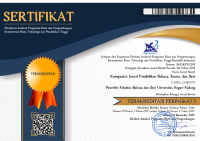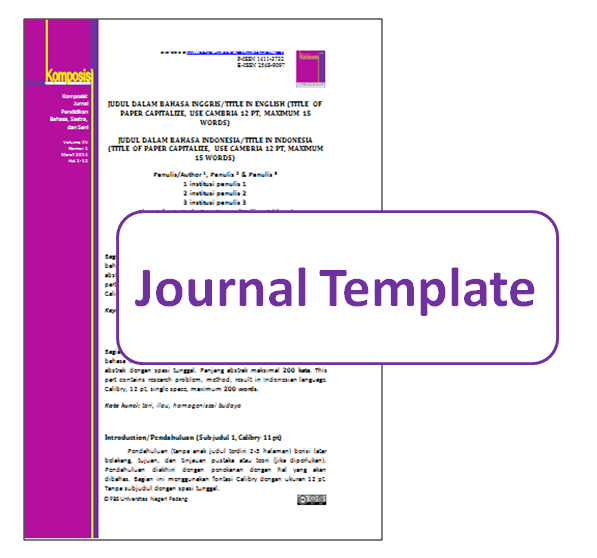PROBLEMATIC SIDES IN IMPLEMENTING LEARNER-CENTERED INSTRUCTION PARADIGM IN ENGLISH CLASSROOM
 ),
), (1) Pascasarjana Universitas Negeri Padang Kampus UNP Air Tawar Padang, 25131, Indonesia
 Corresponding Author
Corresponding Author
Copyright (c) 2017 Komposisi: Jurnal Pendidikan Bahasa, Sastra, dan Seni
DOI : https://doi.org/10.24036/komposisi.v15i2.7381
Full Text:
 Language : en
Language : en
Abstract
Abstract
The implementation of Learner-Centered Instruction paradigm (LCI) is closely related to the role of teachers and students in the classroom. Roles that are run by teachers and students contribute to the successful of LCI implementation. In fact, LCI is still not going well, especially in MAN Solok. Indications suggest that the problems encountered in the implementation of the LCI are closely related to the way teachers and students in implementing their role. This article discusses the implementation of the respective roles of teachers and students in MAN Solok. In addition, this article also discusses the problems arised in the implementation of LCI and its causes.
AbstrakPenerapan paradigma Learner-Centered Instruction (LCI) berkaitan erat dengan peran guru dan siswa dalam kelas. Peran yang dijalankan oleh guru dan siswa berkontribusi terhadap keberhasilan pelaksanaan LCI. Pada kenyataannya, LCI masih belum berjalan dengan baik, khususnya di MAN Kota Solok. Indikasi-indikasi yang ada menunjukkan bahwa masalah yang dihadapi dalam pelaksanaan LCI berkaitan erat dengan cara guru serta siswa dalam menjalankan peran mereka masing-masing. Artikel ini membahas pelaksanaan peran masing-masing guru dan siswa di MAN Kota Solok. Selain itu, artikel ini juga membahas masalah yang muncul dalam pelaksanaan LCI beserta penyebab-penyebabnya.
Kata Kunci: implementasi, learner-centered instruction,paradigma, kelas bahasa Inggris
Keywords
References
Attard, Angele, et al. (2010). Students Centered Learning: An Insight into Theory and Practice. Bucharest: Education and Culture DG.
Bahous, Rima. (2011). Motivating students in the EFL classroom: a case study of perspectives. English Language Teaching. 4: 3. 33-43.
Bennett, Kat, et al. (2010). ‘Learner-centered instruction: an independent study course for adult education and family literacy teachers.’ Retrieved on Monday, 4 June 2012 from http://ae.stvrain.k12.co.us/ncpdc.html.
Brown, Douglas. (1994). Teaching by Principles: An Interactive Approach to Language Pedagogy. New Jersey: Prentice Hall Regents.
Farrell, Thomas. (2008). ‘Reflective practice in the professional development of teachers of adult English language learners.’ Retrieved at 27 December 2012 from http://69.27.107.210/~reflecti/wp-content/uploads/2011/04/ReflectivePracticeFinalWeb-Farrell2.pdf
Harmer, Jeremy. (2001). The Practice of English Language Teaching. Longman.
Hedge, Tricia. (2000). Teaching and Learning in the Language Classroom. Oxford: Oxford University Press.
Hesar, Mohammad, Yafuz Konca, ELham Zarfsam. (2012). Why and how to apply culture in an EFL classroom. International Conferences on Language, Media, and Culture IPEDR. 33: 12. 68-72.
Kilic, Abdurrahman. (2010). Learner-Centered micro teaching in teacher education. International Journal of Instruction. 3: 1. 77-100.
Kojima, Hideo and Yuko Kojima. (2005). ‘Teacher roles in learner-centered communicative EFL instruction.’ Retrieved at 4 June 2012 from http://repository.ul.hirosaki-u.ac.jp/dspace/bitstream/10129/544/1/AN00211590_94_59.pdf.
Kubanyiova, Magdalena. (2006). Developing a motivational teaching practice in EFL teachers in Slovakia: challenges of promoting teacher change in EFL context. TESL English Journal. 10: 2. 1-17.
Lina. (2011). Blogging: Promoting Learners Autonomy and intercultural Competence through Study abroad. Language Learning and Technology. 15: 3. 87-109.
Louis, Rubena. (2003). ‘Helping students become autonomous learners: can technology help?’ Retrieved at 27 December 2012 from http://www.tewtjournal.org/VOL%206/ISSUE%203/03_HELPINGSTUDENTS.pdf
Meece, Judith. (2009). Applying learner-centered principles to middle school education. Theory into Practice. 42: 2. 109-116.
Nonkukhetkhong, Kittipon, Richard Baldauf, and Karen Moni. (2006). Learner-centeredness in teaching English as a foreign language. Thai TESOL International. 1: 1. 1-9.
O’Neill, Geraldine and Tim McMahon. (2005). Students-centered learning: what does it mean for students and lecturers? In Emerging Issues in the Practice of University Learning and Teaching. O’Neill, G., Moore, S., McMullin, B. (Eds). Dublin: AISHE.
Patton, Quinn. (1990). Qualitative Evaluation and Research Methods. 2nd ed. London: Sage Publication ltd.
Pashler, Harold. (1993). ‘Doing two things at the same time.’ Retrieved at 27 December 2012 from
http://www.sjsu.edu/people/steven.macramalla/courses/c1/s1/Pashler____doing_two_things_at_once.pdf
Peyton, Joy, et al. (2010). ‘Evidence-based, students-centered instructional practices.’ Retrieved at 4 June 2012 from www.calorg/caelanetwork.
Rahimi, Mehrak. (2006). What di we want teaching-materials for in EFL teacher training program. Asian EFL Journal. 5: 1. 1-35.
Schiller, Shu. (2011). Practicing learner-centered teaching: pedagogical design and assessment of a second life project. Journal of Information System Education. 20: 3. 369-381.
Thanh, Pham Thi Hong. (2010). Implementing a student-centered learning approach at Vietnamese higher education institutions: barriers under layers of casual layered analysis (CLA). Journal of Future Studies. 15: 1. 21-38.
Tomlinson, Brian. (2012). Materials development for language learning and teaching. Cambridge Journal. 45: 2. 143-179.
Wohflart, Dede, et al. (2008). Students’ perception of learner-centered teaching. A Journal of Scholarly Teaching. 3: 1. 67-74.
 Article Metrics
Article Metrics
 Abstract Views : 467 times
Abstract Views : 467 times
 PDF Downloaded : 95 times
PDF Downloaded : 95 times
Refbacks
- There are currently no refbacks.
Copyright (c) 2017 Komposisi: Jurnal Pendidikan Bahasa, Sastra, dan Seni

This work is licensed under a Creative Commons Attribution-NonCommercial 4.0 International License.











